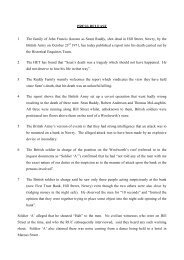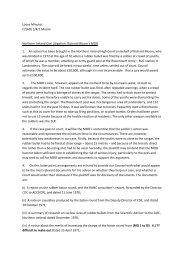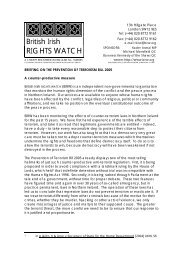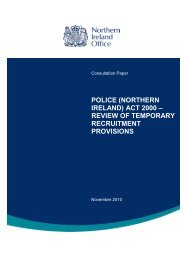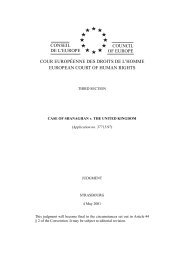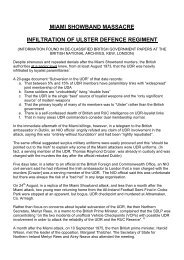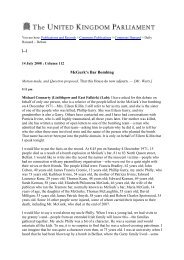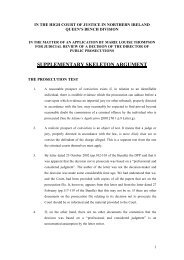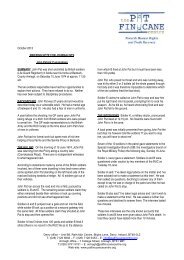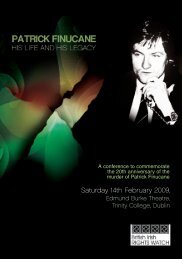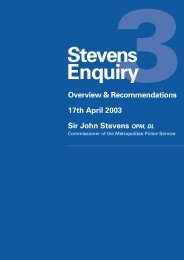HET Review Summary Report into the death of William Francis ...
HET Review Summary Report into the death of William Francis ...
HET Review Summary Report into the death of William Francis ...
You also want an ePaper? Increase the reach of your titles
YUMPU automatically turns print PDFs into web optimized ePapers that Google loves.
time, that <strong>the</strong> soldier was clearly mistaken in his observations, and that<br />
his actions in deliberately shooting McGreanery were clearly wrong.<br />
I feel that <strong>the</strong> only way to establish <strong>the</strong> truth <strong>of</strong> <strong>the</strong> incident to <strong>the</strong><br />
satisfaction <strong>of</strong> everyone is to proceed against soldier “A” for <strong>the</strong> murder<br />
<strong>of</strong> <strong>William</strong> <strong>Francis</strong> McGreanery. I am satisfied that a prima-facie case <strong>of</strong><br />
murder has been established against him and I recommend proceedings<br />
accordingly.<br />
<strong>HET</strong> Comment: Prima facie is a Latin expression that is used in <strong>the</strong><br />
modern English legal system. In layman’s terms it means that on first<br />
examination <strong>of</strong> <strong>the</strong> facts <strong>the</strong> evidence must be sufficient to prove that a<br />
particular <strong>of</strong>fence has been committed and justify criminal proceedings.<br />
On November 15, 1971 <strong>the</strong> Chief Crown Solicitor passed <strong>the</strong> matter to<br />
<strong>the</strong> Attorney General for his observations. As a result <strong>of</strong> what <strong>the</strong><br />
Attorney General said, <strong>the</strong> Chief Crown Solicitor responded to <strong>the</strong> Chief<br />
Constable on December 23, 1971 in <strong>the</strong> following terms:<br />
1. If soldier A was guilty <strong>of</strong> any crime in this case, it would be<br />
manslaughter and not murder. Soldier A whe<strong>the</strong>r he acted wrongly<br />
or not, was at all times acting in <strong>the</strong> course <strong>of</strong> his duty and I<br />
cannot see how <strong>the</strong> malice, express or implied, necessary to<br />
constitute murder could be applied to his conduct.<br />
2. Is <strong>the</strong>re a prima-facie case <strong>of</strong> manslaughter? There is a sharp<br />
conflict between soldier A and <strong>the</strong> civilian witnesses. If <strong>the</strong> latter<br />
are right <strong>the</strong>n <strong>the</strong>re is a clear prima-facie case <strong>of</strong> manslaughter<br />
and if soldier A is right <strong>the</strong>n <strong>the</strong> homicide is not criminal.<br />
Obviously one must look for independent evidence and this is<br />
forthcoming in that <strong>of</strong> Dr. Carson, <strong>the</strong> pathologist. His findings<br />
are that “<strong>the</strong> bullet must have come from <strong>the</strong> front <strong>of</strong> <strong>the</strong><br />
deceased somewhat to his left and slightly above him at a time<br />
when his left forearm was held in front <strong>of</strong> his chest. It could not<br />
have come from his right side.” This evidence destroys most <strong>of</strong><br />
<strong>the</strong> civilian evidence which to be true would require <strong>the</strong> deceased<br />
to be shot on <strong>the</strong> right hand side and certainly not “at <strong>the</strong> time<br />
<strong>the</strong> forearm must have been flexed at <strong>the</strong> elbow and held up in<br />
front <strong>of</strong> <strong>the</strong> chest, ei<strong>the</strong>r vertically or horizontally or in some<br />
intermediate position” – as Dr. Carson says. Dr. Carson’s evidence<br />
does not <strong>of</strong> course prove that <strong>the</strong> deceased had a rifle but it is<br />
27/5/2010<br />
32



